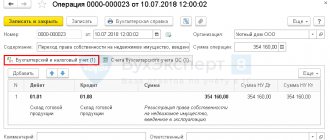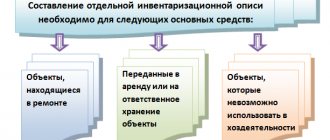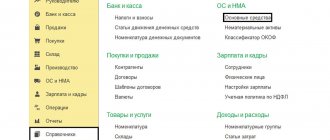As you know, construction and installation work for one’s own consumption is subject to VAT. It would seem that calculating the tax on the cost of construction is not at all difficult. However, in practice this raises a lot of questions among accountants. And not least because changes are constantly being made to the regulatory documents that regulate the rules for paying VAT on construction and installation work. In this article, we tried to answer in detail all the questions that accountants have.
The procedure for calculating VAT during construction and installation works
To calculate VAT when performing construction and installation work for the taxpayer’s own consumption, the following steps are performed sequentially:
- The tax base for completed construction and installation works is calculated.
- The tax period in which VAT must be calculated and the tax amount must be calculated is determined.
- An invoice is drawn up for the cost of construction and installation work performed.
- The amount of VAT on purchased materials, works, services necessary to carry out construction and installation work, and the amount of VAT accrued on the volume of construction and installation work performed are subject to deduction.
- A completed VAT return is submitted to the tax authority.
- Tax is paid to the budget if the declaration reflects the amount of VAT payable.
The concept of “own needs”
The provisions of the current tax legislation do not provide any clarification as to exactly what elements are included in the concept of own needs and what is meant by this concept. If we turn to other rules directly related to tax, we can understand that own needs represent the very procedure of using certain goods , services, or work performed necessary for the functioning of a particular organization.
Here, for example, you can include various economic and household needs, which can be either permanent or one-time, depending on special circumstances and other nuances.
In relation to certain works or services that were carried out and provided for one’s own needs , they will be considered as such only if they were provided or carried out by the organization or other legal entity itself.
As for purchased or supplied goods , they will be a legal object of taxation and can be recognized as goods for one’s own needs only if these goods were involved in the transfer of them from one structural unit to another, with the mandatory execution of all necessary legal documents. In this case, the taxpayer has the right to choose whether finished products will participate in the transfer , or his own and purchased goods, etc.
Another important nuance in the system of taxation of goods, services or works involved in the transfer for one’s own needs is the fact that all associated costs are not taken into account when determining the tax base . Such expenses may include additional expenses, for example, payment for the storage of certain goods, transportation costs, etc.
The obligation to pay these expenses lies with the responsible person - the taxpayer, unless otherwise provided by the provisions of the agreement or relevant other legal acts.
Determination of the tax base for VAT during construction and installation works
The tax base for VAT when performing construction and installation work is determined as the cost of this work. The indicated cost includes all expenses of the taxpayer actually incurred by him during the construction of fixed assets.
If third-party organizations are partially involved in carrying out construction and installation work, then the cost of construction work performed by contractors should not be included in the tax base (see decision of the Supreme Arbitration Court of the Russian Federation dated March 6, 2007 No. 15182/06 and resolution of the Federal Antimonopoly Service of the Ural District dated January 14, 2008 No. Ф09-11071/07-С2). Tax officials also adhere to this position (letter of the Federal Tax Service of Russia dated July 4, 2007 No. ШТ-6-03/527).
Let's understand the terminology
The term “construction and installation works for own consumption” is not directly defined in the text of the Tax Code of the Russian Federation. Therefore, in this case, you need to be guided by the provisions of paragraph 1 of Article 11 of the Tax Code of the Russian Federation: if any term is not defined by tax legislation, then you need to use the definitions that are given in other branches of law.
This approach is shared by tax authorities. To decipher the concept of “construction and installation work for one’s own consumption,” they advise following the definitions contained in the regulations of Rosstat (see letter of the Ministry of Taxes and Taxes of Russia dated March 24, 2004 No. 03-1-08/819/16). From the definition of Rosstat it follows that construction and installation work is work related to capital construction (clause 20 of Rosstat Resolution No. 50 of November 3, 2004).
In accounting, all expenses for capital construction are reflected in account 08 “Investments in non-current assets”. And the Tax Code of the Russian Federation states that the tax base for self-employed construction is equal to the sum of all actual expenses for carrying out construction and installation works for one’s own consumption (Clause 2 of Article 159 of the Tax Code of the Russian Federation).
This gives tax authorities a reason to demand that firms calculate VAT on construction and installation work performed on a self-employed basis based on all costs “collected” on account 08. In other words, fiscal officials believe that, in essence, the cost of construction and installation works for their own consumption is equal to the sum of all capital expenses.
However, in the Tax Code (clause 2 of Article 159) we are not talking about all actual expenses for capital construction of an object, but about all actual expenses for carrying out construction and installation work. And the costs of construction and installation work are only part of the capital costs.
To substantiate this position, we also turn to Rosstat documents. The technological structure of capital investments is given in section 4 of the Instructions for filling out forms of federal state statistical observation on capital construction, approved by Resolution of the State Statistics Committee of Russia dated October 3, 1996 No. 123.
Here she is:
- construction works;
– equipment installation work;
– equipment (requiring and not requiring installation) provided for in construction estimates;
– tools and equipment included in construction estimates;
– other capital works and costs (design and survey work, maintenance of the directorate of buildings under construction, research work to clarify construction and technological design solutions, organized recruitment of workers for construction, etc.).
Thus, of all the costs that form the cost of capital construction projects in account 08, only a part is the cost of construction and installation work (namely, only the first two positions of the above technological structure). All other capital costs are not included in the cost of construction and installation work. This means that there is no need to charge VAT on them (subclause 3, clause 1, article 146 of the Tax Code of the Russian Federation).
The correctness of this approach is also evidenced by arbitration practice (see, for example, the decisions of the FAS of the West Siberian District dated April 14, 2004 in case No. F04/1972-239/A75-2004 and the FAS of the East Siberian District dated April 14, 2005 in case No. A33-5152/04-S3-F02-1396/05-S1).
VAT accrual on construction work
VAT when performing construction work for own consumption must be calculated at the end of each tax period (clause 10 of article 167 of the Tax Code of the Russian Federation). Thus, the taxpayer calculates the amount of VAT on a quarterly basis based on the volume of work that was performed during the quarter.
On the last day of the quarter, an invoice is issued in accordance with Art. 163 of the Tax Code of the Russian Federation and clause 21 of the rules for maintaining a sales book, approved by Decree of the Government of the Russian Federation of December 26, 2011 No. 1137. The document can be drawn up in one copy, since the buyer to whom the second copy should be transferred does not exist as such (clause 6 of the rules for filling out an invoice - invoices approved by Decree of the Government of the Russian Federation dated December 26, 2011 No. 1137). Based on this, in the lines “Seller”, “Consignee and his address”, “Consignor and his address”, “Buyer” it is necessary to enter the details of the taxpayer who carried out the construction work on his own.
An invoice issued in this way is simultaneously registered in the purchase book and the sales book (clauses 3 and 21 of the rules for maintaining a sales book, approved by Decree of the Government of the Russian Federation of December 26, 2011 No. 1137 and paragraph 2 of clause 20 of the rules for maintaining a purchase book, approved by a Government Decree RF dated December 26, 2011 No. 1137).
VAT deduction in construction
When carrying out construction and installation work in an economic way, the taxpayer can claim the following amounts of VAT for deduction:
- VAT paid to suppliers when purchasing materials, works, services used during construction work.
- VAT paid to the seller of an unfinished capital construction project, subsequently completed using economic methods.
- VAT, which was accrued when performing construction and installation work for own consumption.
In this case, the VAT amounts specified in clauses 1 and 2 can be deducted as materials, works, services are received and invoices are received from suppliers (letter of the Ministry of Finance of Russia dated September 21, 2007 No. 03-07-10/20, Federal Tax Service Russia in Moscow dated July 22, 2008 No. 19-11/069325). The data on the amount of input VAT on goods (work, services) purchased for construction and installation work, and the amount of tax presented by contractors, are necessary to calculate the indicator on line 120 of section. 3 VAT declaration forms (paragraph 6, clause 38.13 of the procedure for filling out the declaration, approved by order of the Federal Tax Service of Russia dated October 29, 2014 No. ММВ-7-3/ [email protected] ).
It is necessary to deduct VAT, which was accrued on the amount of expenses incurred during the construction of a fixed asset using one’s own resources, on the last day of the tax period at the time the tax base is determined. This procedure for accepting deductions is established in paragraph. 3 paragraph 6 art. 171 and para. 2 clause 5 art. 172 of the Tax Code of the Russian Federation. Thus, VAT on completed construction work can be deducted in the same quarter in which it was accrued for payment to the budget (letter of the Federal Tax Service of Russia dated March 23, 2009 No. ШС-22-3/ [email protected] ). The specified amount of tax must be reflected in the VAT return in lines 060 “Performing construction and installation work for own consumption” section. 3 and 140 “The amount of tax calculated when performing construction and installation work for own consumption, subject to deduction” section. 3 (clauses 38.3 and 38.10 of the Procedure for filling out a tax return for value added tax, approved by order of the Federal Tax Service of Russia dated October 29, 2014 No. ММВ-7-3/ [email protected] ).
See also “The court recognized the work as completed, but there are no invoices for it. Is it possible to deduct VAT?
In the previous issue of our magazine, we have already begun to gradually restore the “forgotten” VAT in our memory, and throughout this year we will be preparing with you to pay VAT. After all, remember that many agricultural organizations will combine unified agricultural tax and VAT from January 1, 2021 (we wrote a lot about this in the previous issue). In this regard, we will try to gradually consider all the pitfalls of this tax, since VAT, in our opinion, is one of the most complex taxes.
To begin with, I propose to consider the rather difficult issue of calculating VAT on construction and installation work (hereinafter referred to as construction and installation works) for one’s own consumption. Such operations are widespread in many enterprises, because most organizations build production facilities, stores for selling their own products, houses for employees, both with the involvement of third parties and on their own. At the same time, the Tax Code of the Russian Federation provides for the mandatory assessment of VAT on construction and installation work carried out for one’s own consumption.
What is meant by “construction and installation works for own consumption”? After all, such a concept is not provided for in the Tax Code of the Russian Federation.
Essentially, the work should be classified as construction and installation work performed for one’s own consumption if the following conditions are simultaneously met in relation to them:
1. The work is of a capital nature
As the Ministry of Finance of the Russian Federation explains to us, for VAT purposes, construction and installation work should be considered as work of a capital nature, as a result of which real estate objects (buildings, structures, etc.) are created or their initial value changes in cases of completion, reconstruction, modernization and on other similar grounds (Letter dated October 30, 2014 No. 03-07-10/55074). That is, repair work, even if it is of a capital nature, cannot be included here, therefore, it does not arise as an object of VAT taxation.
Construction and installation works also include capital works, as a result of which other fixed assets (besides real estate) are created or the initial cost of operating fixed assets is changed (in cases of completion, additional equipment, reconstruction, modernization, technical re-equipment, partial liquidation and on other similar grounds). This conclusion follows from the Letter of the Ministry of Finance of the Russian Federation dated November 5, 2003 No. 04-03-11/91.
2. The work was performed for their own needs by the organizations’ own resources , that is, the object that is the result of construction and installation works carried out by the taxpayer will be used by him in his own activities, and is not intended for subsequent resale or other disposal.
If you are building an object in order to sell it later, then VAT in this case will arise on the sale of such property.
Summarizing the above, we can conclude that construction and installation work for its own consumption is such construction and installation work as a result of which the organization creates objects intended for use in its own activities. Moreover, the work must be performed by the organization’s own resources (by full-time employees), and the finished object is supposed to be included in the fixed assets.
The first step for correct calculation of VAT when performing construction and installation work for one’s own consumption will be to determine the tax base for VAT when performing construction and installation work for one’s own consumption.
The Tax Code of the Russian Federation does not provide an explanation of the costs associated with carrying out construction and installation works for one’s own needs. As a result, the vagueness of the above wording gives rise to controversy.
In paragraph 2 of Art. 259 of the Tax Code of the Russian Federation states that the tax base for VAT is determined as the sum of all expenses that you actually incurred when performing construction and installation work. Proponents of the fiscal approach propose to charge VAT on the amount of debit turnover in account 08-3 “Construction of fixed assets”, agreeing to exclude from it only the costs of paying contractors for the mixed method of construction (Letter of the Federal Tax Service of Russia dated July 4, 2007 No. ШТ-6-03/ 527, Decision of the Supreme Arbitration Court of the Russian Federation dated March 6, 2007 No. 15182/06, Resolution of the Federal Antimonopoly Service of the Ural District dated January 14, 2008 No. F09-11071/07-S2).
But in our opinion, expenses also cannot be included
— the cost of paying interest on loans and borrowings used to finance construction, because interest costs cannot be identified with the cost of construction and installation work. In addition, the following are not expenses for carrying out construction and installation work for your own consumption:
— the cost of materials transferred to the contractor to perform the work on a toll basis;
— costs of maintaining departments and services created to monitor the execution of work;
— depreciation amounts for fixed assets leased to contractors performing the work.
As a result, the tax base for construction and installation works for own consumption is (clause 2 of Article 159 of the Tax Code of the Russian Federation, Letter of the Federal Tax Service dated 07/04/2007 No. ШТ-6-03/527):
For a more accessible understanding, let’s look at the procedure for determining the tax base for construction and installation work for our own consumption using the following example:
Example. Mayak LLC is constructing a production workshop for its own needs, on its own, and with the partial involvement of a contractor construction organization for certain types of work.
The total cost of construction of the facility for the 1st quarter of 2018 amounted to RUB 1,550,000. and represents:
— wages of full-time employees, taking into account insurance contributions – 800,000 rubles;
— electricity supply, heat supply, transport services allocated for construction – 200,000 rubles;
— building materials – 300,000 rubles;
— services of a contractor – 100,000 rubles;
- construction materials transferred to the contractor on a toll basis - 150,000 rubles.
All costs associated with the construction of a production workshop are collected on account 08, subaccount 08-3 “Construction of fixed assets”. In accounting, costs are reflected by the entry:
Dt 08-3 - Kt 70,69,23,10,60 - 1,550,000 rub.
Following the explanations of the Ministry of Finance of the Russian Federation and the established arbitration practice, to determine the taxable base for VAT, we exclude from the total amount of costs the services of the contractor (100,000 rubles), as well as customer-supplied materials (150,000 rubles)
As a result, the taxable base for VAT in relation to construction and installation works for own consumption will be: 1,550,000 rubles. – 100,000 rub. – 150,000 rub. = 1,300,000 rub.
Next, we determine the tax period for calculating VAT when performing construction and installation works for own consumption. There are no nuances provided here, as in the general case for VAT, the tax period is quarter a (clause 10 of article 167 of the Tax Code of the Russian Federation). That is, at the end of each quarter you analyze all costs collected in subaccount 08-3 “Construction of fixed assets” and calculate the taxable base.
And what is VAT without drawing up an invoice ? single invoice for the cost of construction and installation work performed
The invoice is drawn up on the last day of the corresponding quarter (Article 163 of the Tax Code of the Russian Federation, clause 21 of the Rules for maintaining the sales book, approved by Decree of the Government of the Russian Federation of December 26, 2011 No. 1137).
In the lines “Seller”, “Buyer” the details of the taxpayer who built the object on an economic basis are indicated. In the lines “Consignee and his address”, “Consignor and his address” dashes are placed.
The compiled invoice is registered in the sales book (clause 3, Rules for maintaining the sales book, approved by Decree of the Government of the Russian Federation dated December 26, 2011 No. 1137). At the same time, it is registered in the purchase book (clause 20 of the Rules for maintaining the purchase book, approved by Decree of the Government of the Russian Federation of December 26, 2011 No. 1137).
Based on the conditions of our example, the invoice for construction and installation work of Mayak LLC will look like this:
INVOICE No. 112 dated March 31, 2018(1)
— — —
CORRECTION No. — from “—” —————— (1a)
Mayak LLC
Seller —————————————————————- (2)
630008, Novosibirsk, st. Zheleznodorozhnaya, 6
Address ——————————————————————- (2a)
5427098760/542701001
Seller’s INN/KPP ——————————————————— (2b)
—
Shipper and his address —————————————— (3)
—
Consignee and his address —————————————— (4)
To payment and settlement document No. _________ dated _______________________ (5)
Mayak LLC
Buyer ———————————————————— (6)
630008, Novosibirsk, st. Zheleznodorozhnaya, 6
Address ——————————————————————- (6a)
5427098760/542701001
Buyer’s INN/KPP —————————————————— (6b)
Russian ruble, 643
Currency: name, code ———————————————— (7)
Identifier of the government contract, agreement (agreement) (if available) __________________________ (8)
| Name of goods (description of work performed, services provided), property rights | Product type code | Unit | Quantity (volume) | Price (tariff) per unit of measurement | Cost of goods (works, services), property rights without tax - total | Including the amount of excise tax | Tax rate | Tax amount due to buyer | Cost of goods (works, services), property rights with tax - total | Country of origin of goods | Registration number of the customs declaration | ||
| code | symbol (national) | digital code | short title | ||||||||||
| 1 | 1a | 2 | 2a | 3 | 4 | 5 | 6 | 7 | 8 | 9 | 10 | 10a | 11 |
| Construction and installation works for own consumption. Object: production workshop | — | — | — | — | — | 1300000 | Without excise tax | 18% | 234000 | 1534000 | — | — | — |
| Total payable | 1300000 | X | 234000 | 1534000 | |||||||||
Head Chief Accountant
organization or other Romanov A.P. or other Tarasova V.T.
authorized person ——— ———— authorized person ———- ————-
(signature) (full name) (signature) (full name)
Our next step will be to submit a VAT deduction for the cost of construction and installation work . You have the right to deduct such VAT in the same quarter when it was accrued (paragraph 2, clause 5, article 172 of the Tax Code of the Russian Federation). The deduction cannot be transferred to the future (within 3 years): it does not fall under clause 2 of Art. 171 of the Tax Code of the Russian Federation, since paragraph. 2 clause 5 art. 172 of the Tax Code of the Russian Federation establishes a special rule regarding the moment of application of this deduction.
It is also necessary to remember the following: in order to deduct VAT, the object under construction must be intended for carrying out operations subject to VAT, and the cost of which is subject to inclusion in expenses for the purpose of calculating income tax, Unified Agricultural Tax (Unified Agricultural Tax, Paragraph 3, Clause 6, Art. 171 of the Tax Code of the Russian Federation). The above conditions must be met simultaneously. As a rule, at the time of the start of construction work, the future purpose of the capital construction project is known. Therefore, it is not difficult to determine whether it will be used in transactions subject to VAT or not.
In our case, Mayak LLC is building a production workshop, which is subsequently intended for the production of finished products, the proceeds from the sale of which are subject to VAT. In tax accounting (both in the case of the Unified Agricultural Tax and the general taxation regime), the industrial building will also be included in expenses. Therefore, we can easily accept VAT on the cost of construction and installation work as a deduction. To do this, you need to register in the purchase book the invoice that you compiled when calculating VAT (clause 20 of the Rules for maintaining the purchase book).
Please note, even if it is known in advance that the object will be partially used in activities not subject to VAT, VAT accrued on the cost of construction and installation work is still deductible in full (Letter of the Federal Tax Service dated November 28, 2008 No. ШС-6-3 / [email protected] ).
In addition to VAT on construction and installation works for your own consumption, you can also deduct input VAT on contractors’ work and materials for construction based on incoming invoices, unless, of course, the object under construction is intended for VAT-taxable operations and is accepted as an expense in tax accounting.
If the conditions for the deduction are not met, VAT accrued on the cost of construction and installation work, as well as all input VAT associated with construction, is included in the cost of the object (Letter of the Ministry of Taxes dated April 23, 2004 No. 03-1-08/1057/16).
Since this deduction is applied simultaneously with the calculation of VAT on the cost of construction and installation works carried out on an economic basis, the amounts of calculated and refundable tax are reflected in one tax return.
As a result, the size of the organization’s tax obligations does not change: everything that we accrued is taken for deduction in the same amount. In this regard, individual taxpayers neglect this responsibility - they do not charge VAT and do not claim it as a deduction. Let’s see what the consequences for an organization are of failure to comply with the procedure for calculating VAT on construction and installation work for its own needs.
The consequences of such behavior can be judged from the materials of case No. A40-243329/15 (Resolution of the Ninth Arbitration Court of Appeal dated October 4, 2016 No. 09AP-44597/2016-AK and AS MO dated January 20, 2017 No. F05-21610/2016). The essence of the tax dispute is as follows. The Federal Tax Service Inspectorate, having conducted an on-site tax audit, accrued arrears of VAT, pointing out the unlawful non-inclusion of the cost of construction and installation work for the joint venture in the tax base. At the same time, the Federal Tax Service refused to take into account the amount of accrued tax as part of deductions. In pre-trial proceedings, the organization failed to prove the illegality of the inspectorate’s actions, and therefore the LLC went to court.
The arbitrators reasoned as follows:
— the organization does not dispute the fact that construction and installation work was performed for the joint venture, therefore the inspection justifiably charged VAT;
— in the audited period, the LLC did not declare deductions from the cost of construction and installation work for the joint venture, did not reflect them in tax registers (purchase books) and tax reporting (VAT declaration);
- based on the norms of Ch. 21 of the Tax Code of the Russian Federation, the use of VAT deductions is the right of the taxpayer, is of a declarative nature through their declaration in declarations submitted to the tax authority and can only be implemented if established conditions are met;
— the mere presence of the taxpayer with documents confirming, in his opinion, the right to apply tax deductions, without reflecting (indicating, stating) the amount of deductions in the tax return, is not a basis for reducing the VAT payable to the budget at the end of the quarter;
— the presence of documents that determine the use of tax deductions does not replace their declaration (Resolution of the Presidium of the Supreme Arbitration Court of the Russian Federation dated April 26, 2011 No. 23/11, Determinations of the Supreme Arbitration Court of the Russian Federation dated September 14, 2012 No. VAS-11603/12 in case No. A57-4502/2011, dated 04/03/2013 No. VAS-2342/13 in case No. A44-3194/2012, dated 12/24/2012 No. VAS-16742/12 in case No. A51-21737/2011, Resolution of the Administrative Court of the Moscow Region dated 11/20/2015 in case No. A40-128335 /14, FAS ZSO dated 06/02/2015 in case No. A52-2025/2014, FAS SZO dated 02/26/2013 in case No. A56-49359/2011, etc.).
As a result, the judges decided that the Federal Tax Service correctly accrued the VAT arrears; The LLC's argument that the tax authority has the obligation to determine the tax base, taking into account deductions not declared by the company, is unfounded.
In such a case, the organization, of course, is not deprived of the right to submit updated tax returns and declare tax amounts for deduction, but, firstly, it will not be able to avoid paying penalties and fines accrued by the Federal Tax Service, and secondly, the application of the deduction may be refused due to omission established by paragraph 2 of Art. 173 of the Tax Code of the Russian Federation for a three-year period. Therefore, it is impossible to adhere to the indicated approach (“I will not accrue, because the same amount can be deducted”).
Neglecting the obligation to quarterly charge VAT and prepare invoices will inevitably lead to the accrual of arrears of VAT, penalties and fines, including on the basis of clause 2 of Art. 120 of the Tax Code of the Russian Federation (Resolution of the AS ZSO dated 07/09/2015 No. F04-21029/2015 in case No. A81-4014/2014, upheld by the Ruling of the RF Armed Forces dated 12/01/2015 No. 304-KG15-13496).
Now let's move on to filling out the tax return . When filling out the VAT return for the quarter in which construction and installation works were carried out, indicate in section. 3 (clauses 38.4, 38.11, 38.13 of the Procedure for filling out the declaration):
— VAT accrued on the cost of construction and installation work — in line 060;
- deduction of VAT on contractors’ work - in line 125;
- deduction of VAT on materials for construction and on contractors’ work from line 125 - in line 120;
- VAT deduction for construction and installation works - in line 140.
We've sorted out tax accounting, but what about accounting? How to correctly reflect VAT on the cost of construction and installation work? Everything is quite simple here. We accumulate all construction costs in subaccount 08-3 “Construction of fixed assets”, and we will reflect the VAT accrued on the cost of construction and installation work on the last day of the quarter as follows:
| D 19 - K 68 | VAT accrued on construction and installation works for own consumption |
| D 68 - K 19 | Accepted for deduction of VAT on construction and installation works for own consumption on objects intended for activities subject to VAT |
| D 08-3 - K 19 | VAT on construction and installation works for own consumption is included in the cost of an object intended only for VAT-free transactions |
Based on our example, the accountant of Mayak LLC as of March 31, 2018 will record the following transactions:
Dt 19 – Kt 68 – 234,000 rub.
Dt 68 – Kt 19 – 234,000 rub.
As we indicated above, some constructed objects can also be used in VAT-free activities. For example, these could be residential buildings that organizations build for their employees, since the sale, gratuitous transfer or rental of housing is not subject to VAT (clause 3 of Article 149 of the Tax Code of the Russian Federation).
In this case, you are obliged to calculate VAT on construction and installation work on a business basis, but you no longer have the right to deduct it, and the amount of VAT will be included in the cost of the object (Dt 08-3 - Kt 19). Also, you cannot deduct input VAT from contractors and others organizations for goods, works, services aimed at the construction of a given facility. But this applies only to those objects that, even at the construction stage, were not supposed to be used in transactions subject to VAT.
Example. Mayak LLC is building a mixed-use apartment building to house its employees. Construction costs for the 1st quarter of 2021 are:
- salary including insurance contributions - 500,000 rubles;
— power supply services - 80,000 rubles;
— services of contractors - 1,000,000 rubles, including VAT 152,542 rubles;
— building materials – 200,000 rubles, incl. VAT – 30508 rub.
VAT on construction and installation works amounted to 140,400 rubles. = (500,000+80,000+200000)* 18% (Dt 19 Kt 68).
VAT presented by the contractor, as well as on construction materials - 183,050 rubles. (Dt 19 - Kt 60).
As a result, the entire amount of VAT is included in the cost of an apartment building:
Dt 08-3 - Kt 19 - 183050 rub.
Remember that VAT on construction and installation work for your own consumption does not need to be restored only if the object is put into operation, depreciated and used only in activities subject to VAT.
Also, there is no need to restore the tax if the object is partially used in activities not subject to VAT, but it:
- either by the time of use in non-VAT-taxable transactions it is completely depreciated (paragraph 4, paragraph 6, article 171 of the Tax Code of the Russian Federation);
- or 15 years or more have passed since the facility was put into operation (paragraph 4, paragraph 6, article 171 of the Tax Code of the Russian Federation).
There are situations when a constructed facility can be used in both VAT-taxable and non-VAT-taxable transactions. Then you must restore VAT in a special manner provided for in paragraph 6 of Art. 171 of the Tax Code of the Russian Federation: the tax is restored not at once, but over a period of 10 years, starting from the year in which the object began to be depreciated. The amount of tax to be restored is calculated based on one tenth of the amount of tax accepted for deduction in the corresponding share. The specified share is determined based on the cost of goods shipped (work performed, services rendered, transferred property rights), tax-free and specified in clause 2 of Art. 170 of the Tax Code of the Russian Federation, in the total cost of goods (work, services, property rights) shipped (transferred) for the calendar year.
Please note that there is no need to restore VAT for a calendar year in which the property is not used to carry out operations exempt from VAT and specified in paragraph 2 of Art. 170 of the Tax Code of the Russian Federation (Letters of the Ministry of Finance of the Russian Federation dated September 11, 2013 No. 03-07-11/37461, dated February 12, 2013 No. 03-07-11/3574).
It’s quite difficult to understand, so we’ll show you the restoration of NSD using a specific example.
Example. In April 2021, Mayak LLC put into operation a production facility built on its own, and in May of the same year began accruing depreciation on it.
The cost of construction and installation work amounted to 5,000,000 rubles. VAT in the amount of 900,000 rubles. (RUB 5,000,000 * 18%) was calculated and accepted for deduction in the second quarter of 2018.
The cost of materials used in construction amounted to 3,835,000 rubles, including VAT - 585,000 rubles. (RUB 3,835,000 * 18/118).
During 2021 - 2021 the organization used this building only in activities subject to VAT, and from September 2021 it also began to carry out operations not subject to VAT.
In 2021, the cost of goods (work, services) sold by the taxpayer amounted to 80,000,000 rubles, including revenue from transactions subject to VAT amounted to 65,000,000 rubles, and from transactions not subject to VAT - 15,000,000 rubles.
Since the calculation of depreciation for the administrative building of Mayak LLC began in 2021, the last (tenth) year of VAT restoration will be 2027. (paragraph 5, clause 6, article 171 of the Tax Code of the Russian Federation).
From 2021, the organization will be required to restore VAT. The total amount of VAT accepted for deduction will be 1,485,000 rubles. (900000 + 585000). However, given that in 2021 - 2021. To carry out activities not subject to VAT, this property was not used; there is no need to restore the tax for these two years (2018 - 2019).
1/10 of the tax amount accepted for deduction will be 148,500 rubles. (RUB 1,485,000/10). At the same time, the share of transactions not subject to VAT in the total volume of products shipped during the year will be:
(RUB 15,000,000 /RUB 80,000,000) * 100% = 18.75%.
The amount of VAT that needs to be restored in 2021 is:
148 00 rub. * 18.75% = 27843.7 rub.
In each year, starting from 2021, in the VAT return for the fourth quarter, Mayak LLC will have to reflect in column 6 on line 090 of section 3 the amount of VAT subject to recovery, calculated in the above manner, and decipher the procedure for its formation in the application No. 1 to section 3 of the VAT return (paragraph 5, clause 6, article 171 of the Tax Code of the Russian Federation), having registered an accounting certificate in the sales book (clause 14 of the Rules for maintaining the sales book, approved by Resolution No. 1137).
The amount of tax to be restored is not included in the value of the property, but is taken into account as part of other expenses in accordance with Art. 264 of the Tax Code of the Russian Federation (clause 6 of Article 171 of the Tax Code of the Russian Federation).
If at the time of completion of construction your facility is not subject to commissioning (this happens in our lives), for example, construction was carried out in violation of the relevant standards, and permission to commission the facility was not obtained. In such a situation, the amount of VAT on construction is restored at a time in the tax period in which the decision was made to write off this object from the balance sheet (in particular, in connection with liquidation). This procedure is provided for in paragraph. 4, 5 pp. 2 p. 3 art. 170 of the Tax Code of the Russian Federation (Letter of the Federal Tax Service of Russia dated December 13, 2012 No. ED-4-3/21229).
VAT on construction and installation work is also subject to a one-time recovery in the event that the property put into operation is not accepted as an expense for tax purposes (profit tax, Unified Agricultural Tax, simplified tax system). And also in the event of a transition from the general taxation regime to a special regime (USN, Unified Agricultural Tax, UTII).
Example. LLC "Mayak" is reconstructing the gym in an economic way, which was initially intended to be rented out, but subsequently it was decided that the hall would be intended for free use by the organization's own employees.
The constructed object is not subject to inclusion in expenses for tax purposes on the basis of clause 1 of Art. 252 of the Tax Code of the Russian Federation (both for income tax and for the simplified tax system, unified agricultural tax). Consequently, VAT accrued on construction and installation work in an economic manner is subject to a one-time recovery from the moment the gym is put into operation.
Results
VAT on the construction of fixed assets is calculated and deducted at the end of each tax period.
The basis for calculating the tax is the costs incurred during the construction campaign. VAT refundable is taken into account in the purchase book as materials and work are received, as well as the necessary documentation is received. You can find more complete information on the topic in ConsultantPlus. Free trial access to the system for 2 days.







